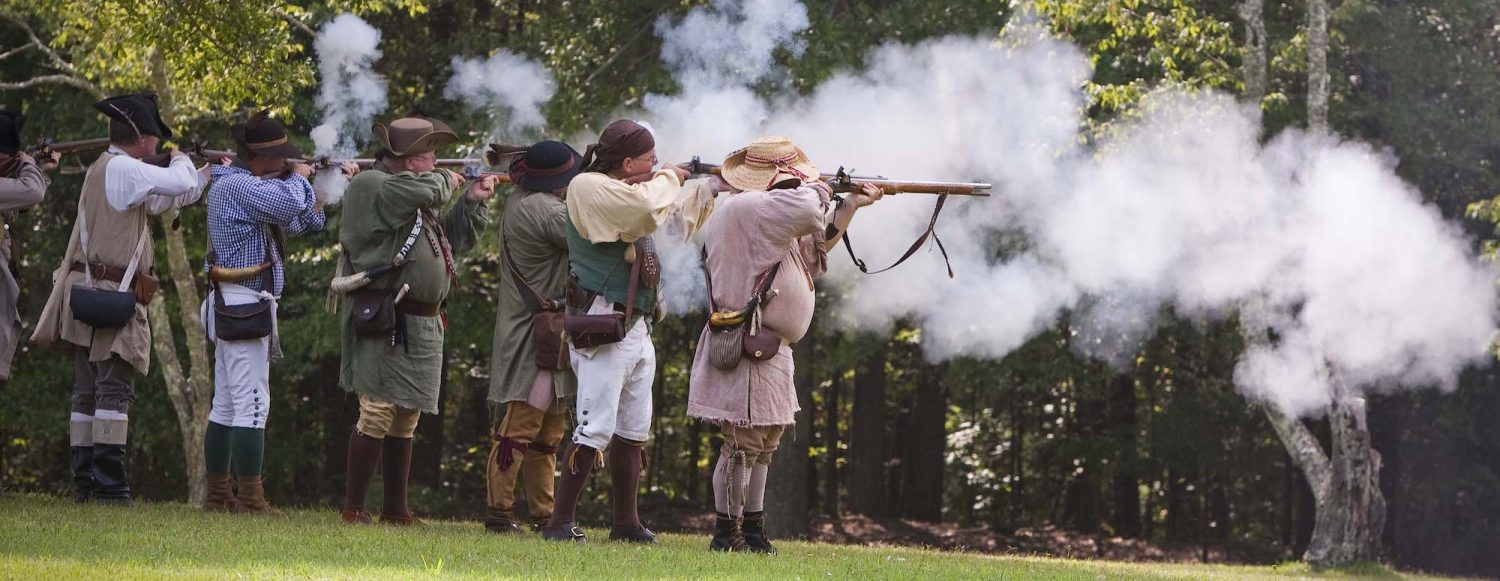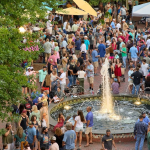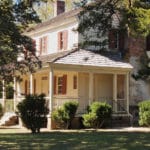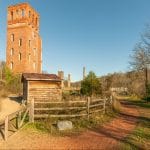Firing of the Muskets at Cowpens National Battlefield
By Jeremy L. C. Jones, HubCity Writers Project
We took a drive up North I-85—moving a lot more quickly than we would’ve been back in mid-January of 1781 if we’d been part of Brigadier General Daniel Morgan’s backcountry irregulars. Of course, Morgan’s men were untrained (but well-tested in battle). But as far as I know none of them were ten years old and named Molly.
We were headed out to the Cowpens National Battlefield, a little daddy-daughter time, to see the South Carolina Independent Rangers put on their Living History Day demonstration.
In other words, we were going to see the SC Rangers fire off their muskets.
As we headed out there, Molly pointed out the horses and cows alongside the meandering Cowpens Battlefield Scenic Highway. The paved but loosely winding road carried us past hay rolls, quiet homes, farmland, agricultural ponds, and a particularly humorous-looking field in which half a dozen llamas stared back toward the way we had come.
To the north, the shadowy silhouette of the Blue Ridge Mountains spread across the horizon. And that fact, perhaps, was part of my growing unease: the Cowpens battlefield was not some distant land, but a familiar grazing meadow over-run by war not that long ago.
Thanks to very clear signage, we found the Battlefield without getting lost. Even with my back-seat navigator keeping me at five miles under the speed limit, we arrived in less than fifteen minutes from the Interstate.
Blacktop wended through the woods, which are still dense with oak and hickory but probably not as thick as they were on January 17, 1781 when the British army, led by Lieutenant Colonel Banastre, marched in from a different direction.
We passed a few history buffs on a stroll and parked outside the Visitor’s Center with minutes to spare. Scrambling to get our things together, we were just about to accost a park ranger when a pack of Cub Scouts from Clinton, SC came tearing out of the building.
“Follow them,” I said, but Molly was already running into the dappled shade of an oak halfway around the building.
“Daddy, come on, they’re starting!”
 Four SC Rangers, dressed in period costumes—rough calico, tri-corner hats—guided us between two trees where we’d be safe when the time came for the firing.
Four SC Rangers, dressed in period costumes—rough calico, tri-corner hats—guided us between two trees where we’d be safe when the time came for the firing.
“There were more battles in South Carolina,” said the Ranger in brown, “than anywhere else. The British didn’t give us the South. We had to win it. The whole war was won right here in the backcountry.”
He looks around, finds the eyes of every chaperone.
“Every man had to furnish his own weapon,” the SC Ranger said, holding up his musket, “his own weapon, powder, and flint.”
A strange thing was happening among the men around me. As we stood there on a crisp fall morning listening to the origins of expressions such as “going off half-cocked” and “keep your powder dry,” a part of us was waiting for the call to action, preparing to gather flint-lock and powder, steeling ourselves to face the British and defend our homes.
“You don’t aim with a gun like this,” the Ranger said. “You point and fire. The best men could load and fire three times per minute.”
I imagined rows of men facing off—aim, fire, load—aim, fire, load. The British were over 1,100 strong, with a mix of foot, horse, and artillery. The Americans had 600 trained Continentals and perhaps as many 400 backcountry musket men, a smattering of rifleman.
“This is the American long rifle,” another SC Ranger said, “It’s not designed for war. It’s for hunting.”
He went on to explain how the rifling inside the barrel—the spiral grooves—spins the lead ball “like a football,” the gyroscopic effect making the weapon much more accurate.
“You’ll notice that this weapon is more graceful,” the Ranger continued. “It would break if you used it as a club. There’s no bayonet, but it does have a sight for aiming.”
The two dozen Cub Scouts leaned forward, riveted by every word. Maybe it was the mention of football; probably it was the guns.
“British soldiers were not trained to think as individuals,” the Ranger said. “A rifleman would take out the officers from a distance and that would knock out the whole army.”
Three of the SC Rangers put in earplugs and the simple gesture sent electricity through the Cub Scouts. “We’re gonna do some firing,” a third Ranger said.
 They fire three times. Each time the lock mechanisms snap on flint, sparks ignite the black powder, contained explosions echo through the woods and return to the billowing smoke like songs of the past, throaty and rich, and the Cub Scouts cheer.
They fire three times. Each time the lock mechanisms snap on flint, sparks ignite the black powder, contained explosions echo through the woods and return to the billowing smoke like songs of the past, throaty and rich, and the Cub Scouts cheer.
The smoke cleared and I counted the crowd to be near three dozen. As intense as the gathering had been moments before the firing, the nine explosions somehow had set us free to go wander the grounds, the battle field, the trails, and to chat about what we had heard.
And, though I did not grow up around here as Molly has, I must admit that as we wandered through the displays of uniforms, sabers, muskets, and canon swabs, and out past the memorial obelisk and under the tree swaddled American flag and back along the winding Cowpens Battlefield Scenic Highway, I’m proud to live among the back-country Carolinians.
Jeremy L. C. Jones, HubCity Writers Project
 Jeremy is a freelance writer, editor, and lecturer living in Spartanburg County with his wife, daughter, and two miniature poodles. He teaches English part-time at Wofford College, volunteers at the Carolina Poodle Rescue’s dog sanctuary, and plays folk ukulele … but not very well.
Jeremy is a freelance writer, editor, and lecturer living in Spartanburg County with his wife, daughter, and two miniature poodles. He teaches English part-time at Wofford College, volunteers at the Carolina Poodle Rescue’s dog sanctuary, and plays folk ukulele … but not very well.






